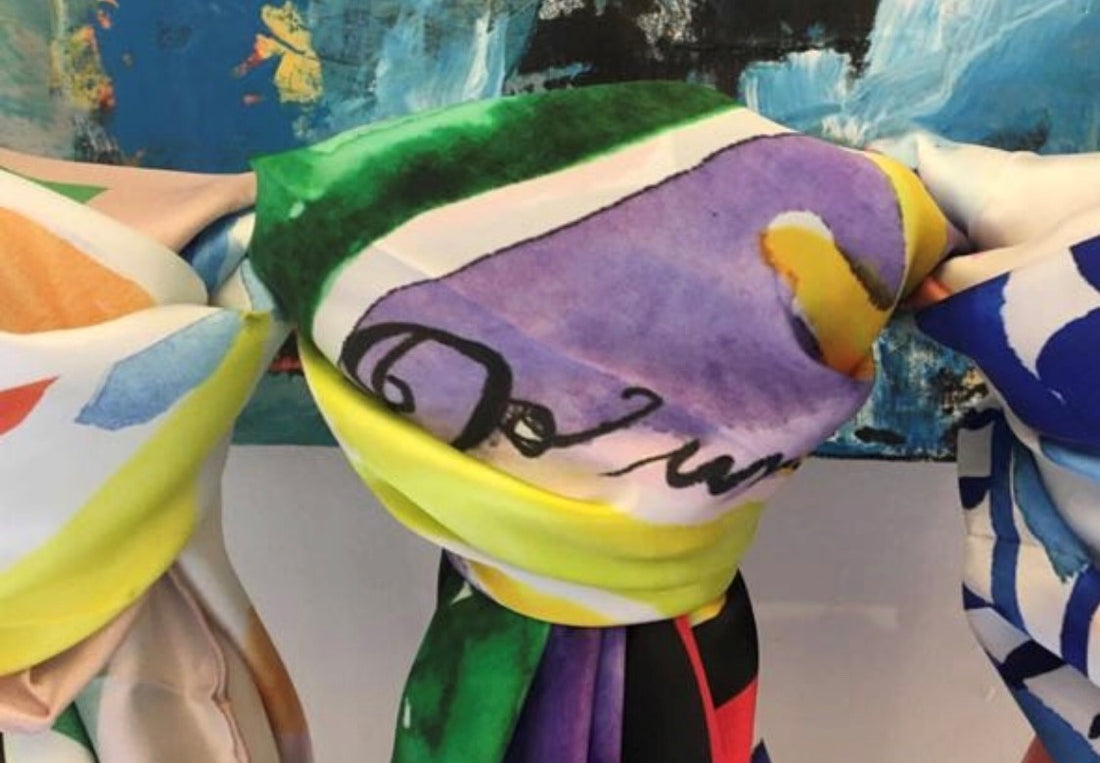
Know your Silk - a miniguide to silk fabrics
At Mantua we use silk satin and silk twill for our scarves. Twill is a strong weave with an obvious weave pattern but still maintains a smooth texture that has an affinity to dye and paint. Satin is a method of weaving fabric in which either the warp or the weft predominates the surface which gives a smooth side and a rougher side. Silk is a type of fabric, made from natural animal fibres. It’s safe to say that 99% of the satin products sold on the market at low prices are *not* made with silk, but with polyester instead, called 'silky' satin because it imitates silk satin.


Silk Satin Silk Twill
So, what is the fundamental difference between silk and polyester? The difference lies in the way these materials are produced. Silk is a naturally spun animal protein fiber, whereas polyester is a industrially produced fiber made from petroleum. As such, silk offers significantly better affinity to skin due to similar chemical composition. Compared to silk’s smooth and light feel on the skin, polyester is hard, brittle and not breathing at all.
The difference between naturally spun silk and factory-produced polyester extends beyond the simple contrast of feel and comfort. Silk is used by cosmetic surgeons and beauty salons around the world as THE material for facial beauty for its smoothness as well as the rich amount of nutrients contained in its fibers.
In 2018 silk continues to have a special allure. Throughout the years it has been prized as a fabric for clothing and home furnishings. But how well do you know your silks? We’ve provided a mini guide to help you with your shopping. We hope you find it useful – please tell us if there is anything else you would like to know!
Charmeuse (Silk Satin)
The silk we have in mind when we think of ‘traditional’ silk, also known as silk satin: The front of the fabric is in a shimmery satin weave, the back of the fabric is a flattened crêpe.
BENEFITS: Charmeuse has more drape than crêpe de chine and works well for scarves, blouses and lingerie
 Chiffon
Chiffon
Silk Chiffon
Literal translation from French means “rag” – although in our context it’s far from it! A light, matt fabric made from fine twisted yarns, spaced out to make the fabric transparent. Dimension is added to garments by the creation of billows of fabric
Unless it is used for scarves, garments with chiffon normally require lining or backing.
BENEFITS: Chiffon is very lightweight making it ideal for special occasion dresses, scarves, even linings.
 Crepe de Chine
Crepe de Chine
Crêpe de Chine means crepe or fabric of China
A lightweight fabric made by fibres, where part of them are twisted clockwise and others in a counter-clockwise direction. These fibres are then woven in a plain-weave fabric. The twisted fibres give crêpe its distinctive ‘pebbly’ look and feel
Comes in many different varieties – crêpe de Chine, Moroccan crêpe and crêpe georgette. Ideal for dresses, suits and evening wear.
BENEFITS: Floaty and soft.
Dupion Silk
A strong double-thread silk, usually resulting in a rough yarn and irregularity in sheerness or weight, it feels coarse and black specks which occasionally appear in the fabric are part of the original cocoon of the silk worm. Removing them would both weaken the fabric and destroy part of its beauty and character. They are inherent to Dupion silk fabric and should not be considered as defects in weaving.
BENEFITS: Strong and lustrous
Shot colours, the use of two different coloured threads in weaving, work well with Dupion silk. This gives the fabric different shades in the light.
 Georgette
Georgette
Georgette
Fine, lightweight, plain weave fabric with a grainy texture and sheer feel.
Less lustrous and heavier than chiffon. Georgette was named after French dressmaker Georgette de la Plante and is used for blouses, dresses, evening gowns and scarves.
BENEFITS: Doesn’t hold creases and drapes beautifully.
Habotai Silk
Also known as China silk, Habutai is the “classic” silk fabric which was first used to line kimonos. A plain-weave fabric, its weight can range from 5mm to the more heavy 12mm. Most scarves are made of 8mm Habotai.
BENEFITS: Soft and lightweight, Habotai silk is a sheer fabric and has a graceful drape and smooth surface. Great for scarves.
 Noil Silk
Noil Silk
Noil Silk
Known as ‘raw silk’ it is made from the short fibres left after combing and carding, so it doesn’t shine like many other silk fabrics but it is a very versatile fabric
It has a matte surface and rough finish, a ‘nubby’ feel and doesn’t show pin holes. It is easily distinguished from other types of silk for the subtle flecks on it, which are natural particles of the cocoon.
BENEFITS: Looks similar to cotton, but still feels soft against the skin. Drapes better than cotton and resists wrinkling. Durable, easy to care for, great for travelling.
TIPS
Should be hand-washed and will look better after every wash than with dry-cleaning.
